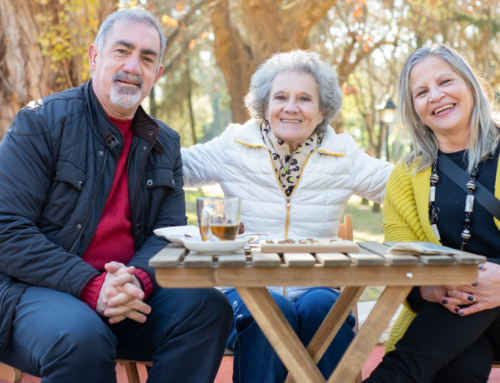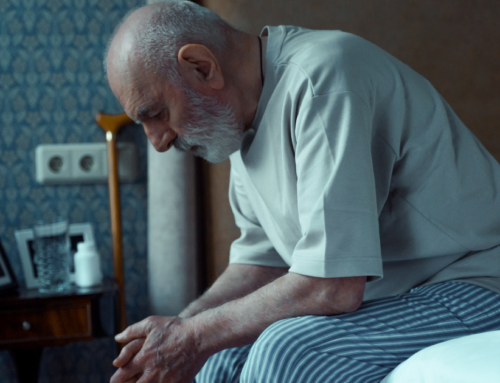Difficulty remembering conversations, names or events, problems speaking, confusion, and behavior changes are some of the most debilitating symptoms of Alzheimer’s Disease and other forms of dementia. Verbal communication is the main way we express ourselves, and when that ability is lost it leaves the person less able to interact and get their ideas, thoughts, and feelings across. But research has shown that the areas of the brain that control creativity remain intact far longer than the areas that control language. As such, art and music have emerged as creative approaches to helping people with dementia express themselves in ways that do not require words.
In an article in Today’s Geriatric Medicine, Music and Art in Memory Care, the author writes: “People living with dementia may lose the ability to express themselves verbally but may sing with great gusto upon hearing a familiar song. An individual who has lost the ability to write may be able to paint an image filled with color. A resident in a wheelchair who can no longer walk can still lift her arms, conducting in time to the rhythm. Among the last remaining abilities in those living with dementia are musical aptitude and appreciation. Because our connection to music remains long after other abilities have passed, music is a compelling way to see beyond the disease process to reach the individual. Combining music with art therapy can further enrich the experience.”
There are wonderful art and music therapy programs that greatly improve the quality of life for individuals with dementia. Many long-term and dementia care facilities provide such programs for their residents. Similar programs are offered by community centers, park districts, art museums and other organizations. (Look on the Momentia website for a calendar of local community programs for those living with dementia). But what about those individuals who are not able to leave their homes to attend an enriching art or music program? Perhaps they are too frail or are reluctant to engage with the outside world. Is there something that family and professional caregivers can do to bring art and music home to their loved one or client?
The answer is “yes.” On the website, Best Alzheimer’s Products, the author of the article Creating Art as Therapy for Alzheimer’s writes, “When words are gone, art becomes a more suitable vehicle for expression. Art therapy can use almost any expressive medium; it need not be limited to painting or drawing.” Using molding clay, creative movement, making up stories, listening to music and singing are just some of the other ways to stimulate an individual’s creativity.
Bringing Art Home
Adding a simple art project to your client or loved one’s routine does not need to be complicated or require a lot of materials. All you need to get started is some paper, a set of watercolors and a brush, or a few colored pencils or markers. The article provides some additional suggestions:
- Create a pleasing, well-lit setting. Play music to set the tone and help stimulate the creative process.
- Use a trigger to get the creative juices flowing. This could be a model (bowl of fruit, vase with flowers, another painting to be copied) or a piece of music or photograph (paint or draw how the music or photo makes you feel). Or you could ask about a favorite pet or animal, an idea (love), or a good memory (Christmas). The trigger is to help the person focus on one subject.
- Have all the materials prepared before beginning the project. Being ready offers a visual clue to what will be happening.
- Talk, ask questions, and offer praise. Even a person who has trouble communicating verbally will often be able to do so when explaining their art.
- Have the artist sign their work. This helps establish pride of creation as well as remind them later that it is something they made.
- Keep it enjoyable. If the person does not want to draw or paint or otherwise participate, don’t push it.
Bringing Music Home
Studies show that music has the power to change moods and lift people’s spirits – including people living with dementia. Hearing familiar music and songs can trigger forgotten memories. In the article, The Effects of Music on People with Alzheimer’s or Dementia on Alzheimers.net it is explained this way: “…because music has emotional content it can trigger emotional memories, which are some of the more powerful memories that we have. Another reason music can be so transformative to people with Alzheimer’s is that when we learn music, we store the knowledge as procedural memory. Procedural memory is associated with routines and repetitive activities. As dementia progresses, episodic memory is destroyed but procedural memory is largely left intact.”
Many care facilities participate in the Music & Memory project which seeks to bring personalized music to those they care for. But finding music that your client or loved one remembers from the past and responds to can be done in any setting, including the home. First, ask the person with dementia what songs they remember or what kind of music they like. Playing songs from old musicals such The Sound of Music, Oklahoma, or The Wizard of Oz, is a great place to start. All you need to do after that is start singing, clapping or tapping your foot along with the music.
All caregivers start their day with a long list of tasks to be accomplished. It is most likely that “play music and sing with my client,” or “help my mother paint a picture,” is not part of the day’s planned activities. But sometimes it is important to take a step back from the care plan and rather than being task-centered for the moment, try being client-centered. Helping someone living with dementia find a new and creative way to express themselves might be the most important thing you can do in the moment.






